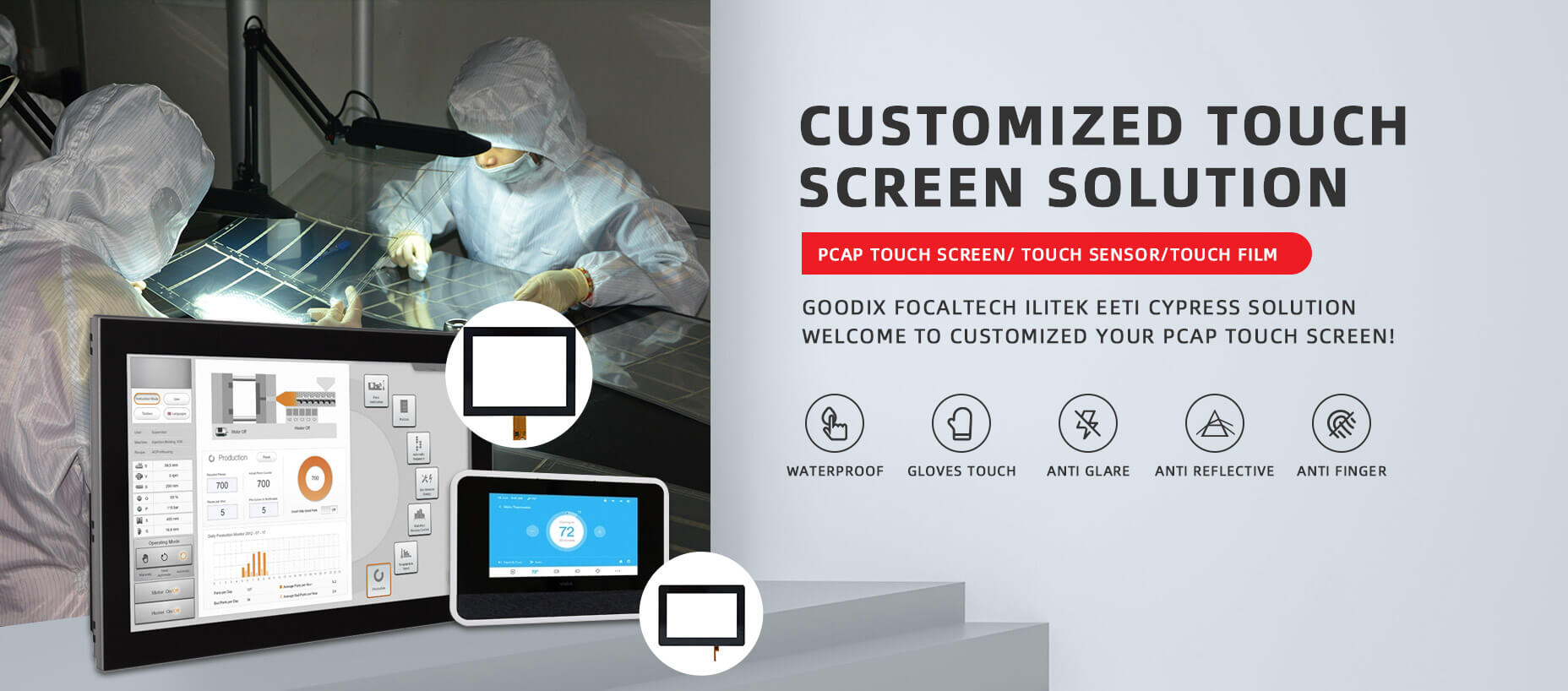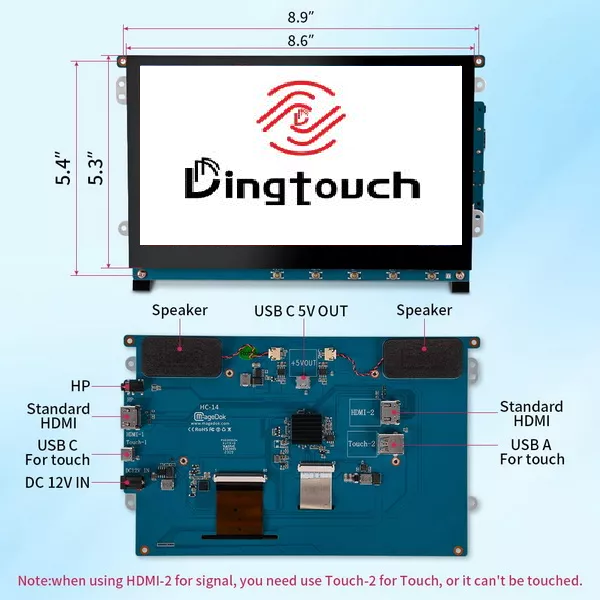News
How To Check Capacitive Touch Screen?
How To Check Capacitive Touch Screen?
Content Menu
● Understanding Capacitive Touch Screen
>> Key Components of Capacitive Touch Screen
● Methods for Testing Capacitive Touch Screen
>> 2. Basic Functionality Tests
>> 5. Signal-to-Noise Ratio (SNR) Testing
● Troubleshooting Common Issues
>> 1. Unresponsive Touch Screen
● Maintenance Best Practices for Capacitive Touch Screen
● Additional Considerations for Capacitive Touch Screen
● Types of capacitive touch screen Technologies
● The Importance of Calibration
● Future Trends in Capacitive Touch Technology
● Frequently Asked Questions (FAQs)
>> 1. What is a capacitive touch screen?
>> 2. How do I know if my capacitive touchscreen is working properly?
>> 3. What should I do if my touchscreen is unresponsive?
>> 4. Can I use gloves on a capacitive touchscreen?
>> 5. How often should I calibrate my touchscreen?
capacitive touch screen are widely used in smartphones, tablets, and various other devices due to their sensitivity and responsiveness. Understanding how to check and test these screens is crucial for ensuring they function properly. This article will provide a comprehensive guide on how to check capacitive touch screens, along with methods, tools required, and troubleshooting tips.
Understanding Capacitive Touch Screen
capacitive touch screen work by detecting the electrical properties of the human body. They consist of a glass panel coated with a transparent conductive material, usually indium tin oxide (ITO). When a finger touches the screen, it alters the electric field around the sensors, allowing the device to register the touch.
Key Components of Capacitive Touch Screen
- Glass Panel: Protects the underlying components and provides a smooth surface.
- Touch Sensors: A grid of conductive materials that detect changes in capacitance when touched.
- Controller: Processes signals from the sensors and translates them into data.
- Display: Shows the visual output of the device.
Methods for Testing Capacitive Touch Screens
Testing capacitive touch screens involves various methods to ensure their functionality. Here are some effective approaches:
1. Visual Inspection
Start with a thorough visual inspection of the screen. Look for:
- Cracks or scratches
- Dust or grease that could interfere with touch detection
- Any foreign objects on the screen
2. Basic Functionality Tests
Perform basic functionality tests to ensure the screen responds accurately:
- Tap Test: Gently tap different areas of the screen to see if it registers touches.
- Swipe Test: Perform swipe gestures across the screen to check for smoothness and responsiveness.
3. Sensitivity Testing
To assess sensitivity:
- Use a stylus pen or your finger to press different areas with varying pressure levels.
- Note any areas that do not respond well or require more pressure than others.
4. Automated Testing
For more comprehensive testing, consider automated systems:
- Robot-Assisted Testing: Utilize robotic arms equipped with styluses for consistent taps and swipes on the screen.
5. Signal-to-Noise Ratio (SNR) Testing
SNR testing helps determine how well the capacitive touch system differentiates between actual touches and background noise. Tools like CapTIvate Design Center can be used for this purpose.
6. Calibration Procedures
Calibration is crucial for accurate touch detection:
- Follow manufacturer guidelines for calibrating based on environmental conditions.
- Regularly recalibrate after significant changes in usage patterns or software updates.
Troubleshooting Common Issues
If you encounter problems with your capacitive touch screen, here are some common issues and their solutions:
1. Unresponsive Touch Screen
- Check for Foreign Matter: Dust or grease can interfere with touch detection. Clean the screen with a microfiber cloth.
- Inspect for Damage: Check for cracks or scratches that may affect functionality.
2. Lack of Sensitivity
- Thick Glass: If the glass is too thick, it may reduce sensitivity. Recalibrate the touch firmware if necessary.
- Using Gloves: Wearing gloves can affect touch recognition. Consider using conductive gloves designed for touchscreen use.
3. Ghost Touches
Ghost touches occur when random touches are registered without user input. Solutions include:
- Disable Certain Features: Some devices allow disabling specific gestures that may be causing ghost touches.
- Recalibrate the touchscreen: Run calibration tools available in device settings.
Tools Required for Testing
To test capacitive touch screens effectively, you may need several tools:
- Capacitive touchscreen Tester: A specialized device designed to assess touch sensitivity and accuracy.
- Multimeter: Useful for checking electrical connections and diagnosing faults.
- Stylus Pen: A rubber-tipped stylus can simulate finger touches without damaging the screen.
Maintenance Best Practices for Capacitive Touch Screen
Maintaining your capacitive touch screen is essential for prolonging its lifespan and ensuring optimal performance. Here are some best practices:
Regular Cleaning
Routine cleaning is vital to remove fingerprints, dust, and other contaminants that can affect touch sensitivity:
- Use a microfiber cloth or specialized cleaning wipes designed for electronics.
- Avoid using harsh chemicals or abrasive materials that could scratch or damage the screen.
Protective Measures
Consider applying a high-quality screen protector to prevent scratches and damage from drops or impacts.
Avoid Excessive Pressure
When using your touchscreen device, avoid pressing too hard on the surface as this can damage internal components over time.
Environmental Factors
Keep your device away from extreme temperatures and direct sunlight, which can affect performance and longevity.
Additional Considerations for Capacitive Touch Screen
Capacitive touch screens have become ubiquitous in modern technology due to their advantages over resistive screens—primarily their ability to detect multiple simultaneous touches (multi-touch) and their higher durability against wear and tear.
Types of capacitive touch screen Technologies
There are primarily two types of capacitive touch technologies used today:
1. Surface Capacitive Technology: This method uses one layer of conductive material that covers an entire surface area. It detects changes in capacitance when a finger approaches or touches it. This technology is less sensitive than projected capacitive technology but is often more cost-effective for simpler applications.
2. Projected Capacitive Technology (PCAP): This method uses multiple layers of electrodes arranged in a grid pattern beneath a glass surface. It allows for more precise detection of multiple simultaneous touches while also supporting gestures like pinch-to-zoom and swipe actions. PCAP technology has become standard in high-end smartphones and tablets due to its superior performance characteristics.
The Importance of Calibration
Calibration plays an essential role in maintaining accuracy in capacitive touch screens:
- It ensures that all parts of the screen respond uniformly to touches.
- Calibration adjusts settings based on environmental factors such as temperature and humidity which can affect performance.
Regular calibration checks should be part of routine maintenance practices especially in devices used in varying conditions such as industrial environments where dust and moisture might be prevalent.
Future Trends in Capacitive Touch Technology
As technology evolves, so does capacitive touch technology:
- Increased Sensitivity: Future developments aim at enhancing sensitivity further allowing even lighter touches to register effectively.
- Integration with Other Technologies: The integration of haptic feedback systems will allow users not only to see but also feel responses from their interactions with screens which could revolutionize user experience across devices.
By staying informed about these advancements, users can better appreciate their devices' capabilities while also being proactive about maintenance and testing practices that ensure long-term functionality.
Conclusion
Testing capacitive touch screen is essential for ensuring they operate correctly and respond accurately to user inputs. By following these methods and troubleshooting tips, you can effectively check your capacitive touch screen's functionality and address any issues that may arise.
Frequently Asked Questions (FAQs)
1. What is a capacitive touch screen?
A capacitive touch screen is a display that detects touch through electrical properties of the human body, allowing for precise interactions without requiring pressure.
2. How do I know if my capacitive touchscreen is working properly?
You can perform visual inspections, basic functionality tests (tap and swipe), sensitivity testing, and automated testing to ensure proper functioning.
3. What should I do if my touchscreen is unresponsive?
Check for dirt or grease on the screen, inspect for physical damage, clean it gently, and restart your device to see if it resolves temporary glitches.
4. Can I use gloves on a capacitive touchscreen?
Standard capacitive screens typically do not work with gloves unless they are specially designed conductive gloves that can interact with the screen.
5. How often should I calibrate my touchscreen?
It's advisable to recalibrate your touchscreen after significant changes in usage patterns, software updates, or environmental conditions affecting its performance.
In summary, understanding how to check capacitive touch screens thoroughly enhances user experience by ensuring devices function optimally while also extending their lifespan through proper care and maintenance practices.
DINGTouch :Committed to continuous innovation and improvement of product quality to meet customers' high requirements and expectations.
DINGTouch is a manufacturer that provides high quality touch screen panels. Focus on the design, manufacturing and sales of touch screen panels, and are committed to providing customized solutions that satisfy customers.
DINGTouch: In the process of customizing touch screen panels, we focus on close cooperation and communication with customers. Understanding customers' needs and providing customized solutions will meet customers' individual needs. The company's products are favored by customers for their high quality and reliability, and provide them with the best touchscreen panel solutions.
At DINGTOUCH, we are the world's leading touchscreen manufacturer, helping businesses around the world take advantage of this exciting technology. For more information, please visit the home page now.
Find the DINGTouch technical team to achieve the success of your company's new project.
How to choose touch screen customization?
DINGTouch is a company specializing in the R&D and production of touch screen technology, headquartered in Shenzhen, China. As a professional touch screen supplier, DINGTouch is committed to providing high-quality, stable and reliable touch screen products to meet the diverse needs of customers. We continue to carry out technological innovation and product optimization to ensure that its touch screen products have good sensitivity, accuracy and durability.
In addition to the products themselves, we also focus on cooperation and communication with customers, and are committed to providing customized solutions and excellent after-sales services. Through continuous efforts to improve product quality and customer satisfaction, we have established a good reputation in the touchscreen industry and won widespread market recognition.
What DINGTOUCH can do:
• PCAP maximum size 65”
• Multi-touch (Touch screen can be customized to your needs.)
• Optical bonding service/air bonding
• LCD interface: HDMI/RGB/MIPI/LVDS/EDP, etc.
• PCAP interface: IIC/USB interface
• CTP can customize the cover glass surface treatment process AG (anti-glare), AR (anti-reflection), AF (anti-fingerprint), waterproof, and glove touch
• Supports 0.55 mm-12 mm coverslip touch.
• Support operating temperature: -40℃-90℃.
Dingtouch Industrial Capacitive Touch Screen Manufacturer
In conclusion, Dingtouch as a professional touch screen manufacturer with more than 10 years touch screen experience.We have many capacitive touch screen. Such as5 inch touch screen,7 inch touch screen,10.1inch touch screen,15 inch touch screen,15.6 inch touch screen,17 inch touch screen,18.5 inch touch screen,19 inch touch screen,21.5 inch touch screen,32 inch touch screen, However, we also welcome to customize your own touch screen . Contact our team today to learn what capacitive touch screen are best for our retail business needs.
Contact us NOW! sales@szdingtouch.com

CATEGORIES
CONTACT US
Contact: Dingtouch
Phone: +8615815536116
Tel: +8615815536116
Email: sales@szdingtouch.com
Add: Building A, Bailu Plaza, No. 48, Gonghe Industrial Road, Gongle Community, Xixiang Street, Baoan District, Shenzhen,China. 518126








 Dingtouch
Dingtouch